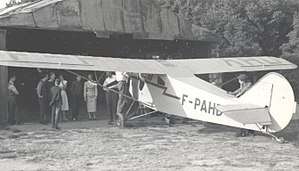Adam RA-14 Loisirs
The RA-14 Loisirs was a French two-seat high-wing light touring aircraft designed by Roger Adam shortly after World War II.
| Adam RA-14 Loisirs | |
|---|---|
 | |
| RA-14 Loisirs at Mery-sur-Oise airfield near Paris in May 1957 | |
| Role | light sporting high-wing cabin monoplane |
| National origin | France |
| Manufacturer | Etablissements Aeronautiques R. Adam |
| Designer | Roger Adam |
| First flight | 16 March 1948[1] |
| Status | Rights sold to Maranda Aircraft Company LTD in 1957 |
| Primary user | private owners and aero clubs |
| Variants | Falconar AMF-S14 |
Design and production
The Loisirs ("Leisure") was designed in May 1945 by Roger Adam and built by Etablissements Aeronautiques R. Adam. It was a tube, wood and fabric two-seater suitable for amateur construction. It was a high-wing braced monoplane of with fixed tail-wheel undercarriage. The seats were positioned side-by-side.[2]
The company sold plans and manufactured parts for the aircraft which could be fitted with a range of engines of between 65 and 80 hp (48 and 60 kW). These included the Régnier 4D, Continental A65, Continental A75 and Continental C90 engines.
Variants
The design rights were sold in 1957 to the Maranda Aircraft Company of Canada who sold plans for amateur construction of the RA14BM1 Loisirs as the Falconar AMF-S14. More than 30 examples were built in North America.[2]
- Adam RA-14 Loisirs
- Falconar AMF-S14
- Homebuilt variant
- RA-14 SL "Super Loisirs"
- modified wing and tail with trim tabs [3]
Survivors
Of the French production of 40 Loisirs, 17 were active in 1965 and five were still flying in the country in 2001.[4]
Specification
Data from Airlife's World Aircraft[4]
General characteristics
- Crew: 2
- Length: 6.99 m (22 ft 11 in)
- Wingspan: 10.90 m (35 ft 9 in)
- Height: 2.21 m (7 ft 3 in)
- Wing area: 16.0 m2 (172 sq ft) [5]
- Empty weight: 279 kg (616 lb)
- Gross weight: 479 kg (1,056 lb)
- Powerplant: 1 × Continental A65 air-cooled flat-four, 48 kW (65 hp)
Performance
- Maximum speed: 140 km/h (87 mph, 76 kn)
- Cruise speed: 121 km/h (75 mph, 65 kn)
- Range: 450 km (280 mi, 240 nmi)
- Service ceiling: 4,000 m (13,000 ft) [5]
References
| Wikimedia Commons has media related to Adam RA-14 Loisirs. |
- Notes
- Bridgman, Leonard, ed. (1947). Jane's all the World's Aircraft 1947. London: Sampson Low, Marston & Co. p. 118c.
- Green, 1965, p. 34
- "none". Air Progress Sport Aircraft: 76. Winter 1969.
- Simpson, 2001, p. 3
- Taylor 1965, pp. 24–25.
- Bibliography
- Green, William (1965). The Aircraft of the World. Macdonald & Co. (Publishers) Ltd.
- Simpson, Rod (2001). Airlife's World Aircraft. Airlife Publishing Ltd. ISBN 1-84037-115-3.
- Taylor, John W. R. (1965). Jane's All the World's Aircraft 1965-66. London: Sampson Low, Marston.